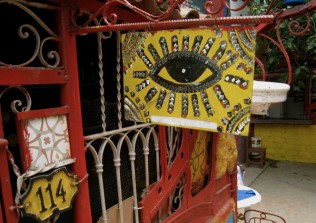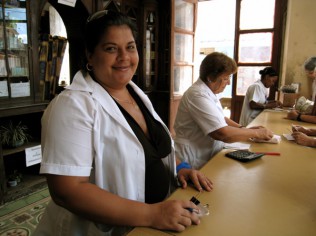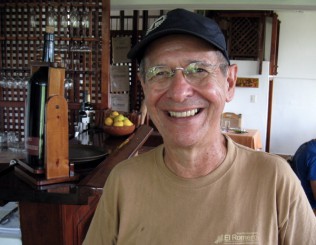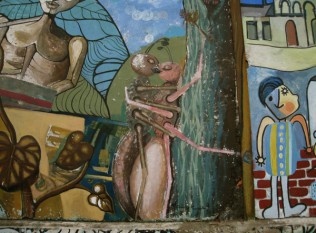Let me level with you, readers. I came here with big plans for writing concise, revealing dispatches, in 800 words or less. But Cuba is one of the most complex, nuanced societies I’ve visited, awash in delights and frustrations. It would be a maddening place to make sense of even if it wasn’t in the middle of an historic transition, gravitating from a Marxist dictatorship toward an era of increased (though hobbled) opportunity. Moving, in short, from Fidel to Ra˙l.
All I can offer you is impressions, and there are so many that I spend the half of every day in a dizzy tug-of-war between a desire to experience everything and a desperation to type up my notes.
* * *

So much about Cuba is better than I dreamed it would be. On our way back to Havana from the coastal beach, we stopped at a highway rest stop for piña coladas. What you get is a tall, cold glass of coconut-pineapple juice. There are two full bottles of 3-year-old Havana Club rum standing on the bar. You mix your own drink—weak or strong—as the grinning bargirl, adorable in braces, practices her maracas for her salsa band.
Cuba is a place to be jealous of, a country that seems to be having the kind of good time you thought was only for a part of your life: the part you thought was mostly over.
My point of view as an American visitor, of course, is wildly skewed. I’ll never have to apply for a driver’s license in Cuba, or apply for a building permit. I’ll never long for a snack or an iPod I can’t afford, never be denied a passport, never look north over the Gulf of Mexico and think of the uncle I’ve never met.
But for the open-minded traveler the country is musical, artistic, welcoming and warm. Aside from a few “friendship” ambassadors who toe the party line, few people we’ve spoken with are playing a part, much less looking over their shoulders. The artists and musicians we meet, often spontaneously, are having the time of their lives. (Artists and musicians, ironically, are among the only people in Cuba who can become relatively wealthy; there is no rule that forbids people from selling things they create themselves.)

The sense of community spirit is obvious when we drive through the towns, or along the highway—the streets and towns are supernaturally clean. But the best signs of solidarity come, as always, in hard times. When things get tough in Cuba—and they’ve been tough since 1990—people don’t talk about how they can overthrow the weakened regime. Their main concerns seems to be helping each other out.
The truth is that Cuba, like the United States, is an experiment. It’s an honest effort at strict socialism. Education is free and compulsory through ninth grade. Food, in scarce times, is directed toward the neediest, and day care is a constitutional right. But this is the time when things are getting interesting. Forced into self-sufficiency by the collapse of the Soviet Bloc, Cuba—at least for the past 20 years — has become a place where, as one of our guides put it, “Everything is possible, and everything is impossible.” She should know; for years, her position as a tourist guide was supported by the state. Now she’s being cut off, and compelled to build her own business—with little official support, less capital, and no infrastructure to fall back on.
But if Cuba isn’t a socialist paradise, it isn’t even remotely a failure. It is a completely different system from anything I’ve seen elsewhere—and parts of that difference are seductive. Right now we’re in Comunidad Las Terrazas, a lush hillside town where 167 families manage, from within, one of Cuba’s six biosphere reserves, Thirty percent of the community’s revenue comes directly from tourism; launched in 1994, Terrazas is the only community in Cuba that is supported by the growing tourism economy. The small town of whitewashed, red-roofed houses and apartments reminds me, at least ideal-wise, of the agrarian communes my friends and I dreamed about starting in the late 1960’s and early 1970’s. The place has its own schools, a coffee shop (Maria’s, serving locally-roasted coffee), a home-grown perfumery, three resident painters (good ones, too), and one of the county’s only two vegetarian restaurants.
* * *

Tito Nuñez, who is 59, vividly remembers the Revolution. His mother was a nurse, and his father a doctor. For years, as they worked with villagers, they were paid with animals: goats, pigs, chickens, even lobsters. But Nuñez hated seeing the animals slaughtered. He decided to do something about it: he’d offer an alternative to the island’s meat-based cuisine.
A series of physical ailments in his late 30’s sealed Nunez’s decision to become a vegetarian. “I suffered from so many thingsÖ diabetes, gastric disorders, allergiesÖ but when I began to eat vegetarian, my health quickly improved.” He opened his first restaurant, Bamboo, in Havana’s Botanical Gardens. In 1996, he was invited to the Terrazas community, where he started the Eco-Restauranté El Romero.
It’s the kind of place you’d be happy to find in San Francisco, or Austin. While pasta, some grains and olive oil are imported, most of the vegetables are locally grown. Dishes include beautiful salads, a ceviche made of lotus roots, savory black beans wrapped in thick homemade tortillas, a flavorful “steak” of tempeh and eggplant, tempura vegetables, and some of the best rolls I’ve tasted in Cuba.
Aside from his role as the restaurant’s chief executive and master chef, Nuñez also teaches children and local farmers about nutrition and agricultural strategies. So far he’s trained more than 56 young students; the big question, as always, is whether or not they’ll pursue this interest after their more formal education.
Cuba is not renowned for its food, but our meal at El Romero was memorable. It’s obvious that Nuñez could be one of Cuba’s real entrepreneurial success stories, opening restaurants all over the island. I put this to him—but he already has a plan.

Nuñez’s personal dream is to satisfy a true Cuban obsession (and one of mine). Someday, he hopes to open a cooperative ice cream parlor serving all-natural, non-sugar products made with fresh fruits and natural ingredients. At present, two main obstacles stand in his way. First, a machine to churn the ice cream is very expensive, and he has almost no capital. “That,” he says soberly, “is one of the problems we have to lose.” The next is a bit thornier. Though it is supposedly in process, there are no laws yet for creating a cooperative, yet privately run, enterprise in Cuba.
Even when that law is ratified, there may be another issue. Havana already has a wildly popular ice cream parlor: Coppelia. It’s a virtual urban park, filling an entire city block. Does he think he can compete with this gigantic, state-run enterprise?
Nuñez provides a shy but confident grin. “Absolutely,” he says. “I have no doubt about that.”
When he serves us home-made ice cream for dessert—three scoops of honey vanilla—I’m inclined to agree.
Read Ethical Traveler's Reprint Policy.
